The cubists found a picture dealer, the young Kahnweiler, coming from London, full of enthusiasm, wishing to realise his dream of becoming a picture dealer, and hesitating a little here and there and definitely becoming interested in Picasso. In 1907 and in 1908, in 1909 and in 1910, he made contracts with the cubists, one after the other, French and Spanish and he devoted himself to their interests. The life of the cubists became very gay, the gaiety of France once again seduced Picasso, every one was gay, there were more and more cubists, the joke was to speak of some one as the youngest of the cubists, cubism was sufficiently accepted now that one could speak of the youngest of the cubists, after all he did exist and every one was gay. Picasso worked enormously as he always worked, but every one was gay.
This gaiety lasted until he left Montmartre in 1912. After that not one of them was ever so gay again. Their gaiety then was a real gaiety.
He left the rue Ravignan, 1911, to move to the boulevard de Clichy and he left the boulevard de Clichy and Montmartre to settle in Montparnasse in 1912. Life between 1910 and 1912 was very gay, it was the period of the Ma Jolie picture, it was the period of all those still lifes, the tables with their grey color, with their infinite variety of greys, they amused themselves in all sorts of ways, they still collected African sculpture but its influence was not any longer very marked, they collected musical instruments, objects, pipes, tables with fringes, glasses, nails, and at this time Picasso commenced to amuse himself with making pictures out of zinc, tin, pasted paper. He did not do any sculpture, but he made pictures with all these things. There is only one left of those made of paper and that he gave me one day and I had it framed inside a box. He liked paper, in fact everything at this time pleased him and everything was going on very livelily and with an enormous gaiety.
Everything continued but there were interruptions, Picasso left Montmartre in 1912 and gaiety was over everything continued, everything always continues but Picasso was never again so gay, the gay moment of cubism was over.
He left Montmartre for Montparnasse, first the boulevard Raspail, then the rue Schoelcher and finally Montrouge.
During all this time he did not return to Spain but during the summer he was at Ceret or at Sorgues, the beginning of life in Montparnasse was less gay, he worked enormously as he always does. It was at the rue Schoelcher that he commenced to paint with Ripolin paints, he commenced to use a kind of wall paper as a background and a small picture painted in the middle, he commenced to use pasted paper more and more in painting his pictures. Later he used to say quite often, paper lasts quite as well as paint and after all if it all ages together, why not, and he said further, after all, later, no one will see the picture, they will see the legend of the picture, the legend that the picture has created, then it makes no difference if the picture lasts or does not last. Later they will restore it, a picture lives by its legend, not by anything else. He was indifferent as to what might happen to his pictures even though what might happen to them affected him profoundly, well that is the way one is, why not, one is like that.
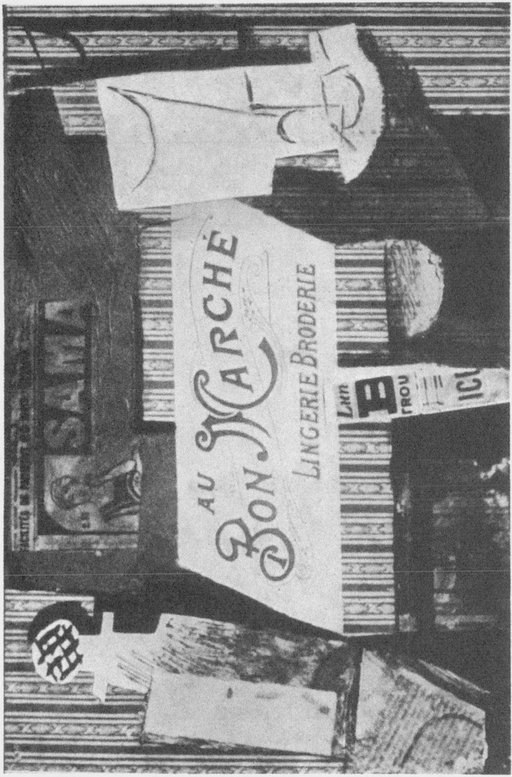
30 “AU BON MARCHÉ” : Oils and Cut Paper (Spring, 1913)
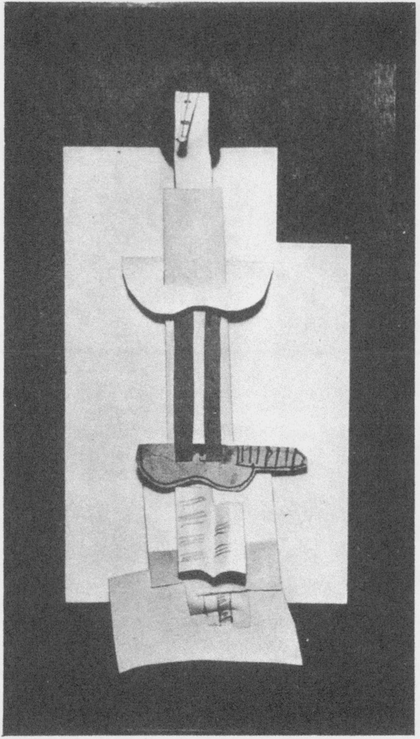
31 L’HOMME AU LIVRE : Composition in Cut Paper (1913)
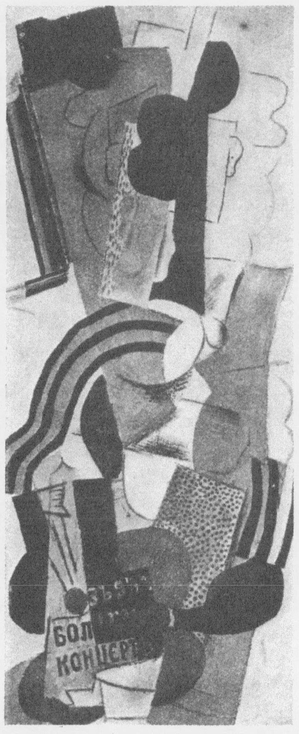
32 NATURE MORTE AUX LETTRES RUSSES (1914)
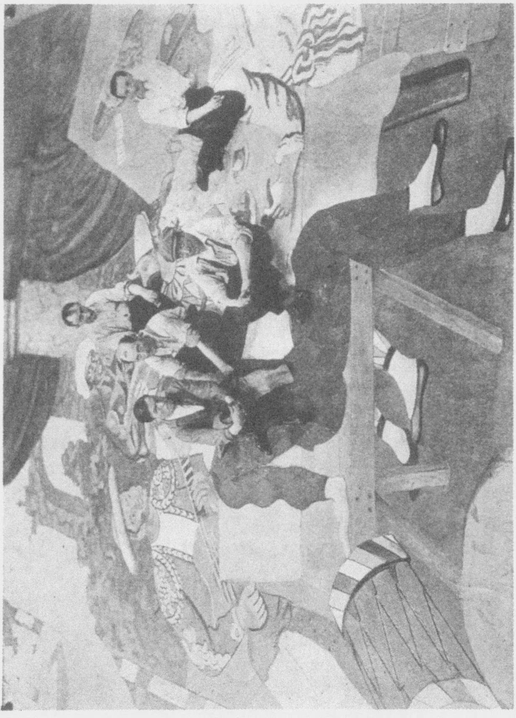
33 “PARADE” : Picasso and his Assistants preparing the Scenery (1917)
Very much later when he had had a great deal of success he said one day, you know, your family, everybody, if you are a genius and unsuccessful, everybody treats you as if you were a genius, but when you come to be successful, when you commence to earn money, when you are really successful, then your family and everybody no longer treats you like a genius, they treat you like a man who has become successful.
So success had begun, not a great success, but enough success.
At this time, he was still at the rue Schoelcher, and Picasso for the first time used the Russian alphabet in his pictures. It is to be found in a few of the pictures of this period, of course this was long before his contact with the Russian ballet. So life went on. His pictures became more and more brilliant in color, more and more carefully worked and perfected and then there was war, it was 1914.
At this period his pictures were very brilliant in color, he painted musical instruments and musical signs, but the cubic forms were continually being replaced by surfaces and lines, the lines were more important than anything else, they lived by and in themselves. He painted his pictures not by means of his objects but by the lines, at this time this tendency became more and more pronounced.
Then there was the war and all his friends left to go to the war.
Picasso was still at the rue Schoelcher, Braque and Derain were mobilised and at the front but Apollinaire had not yet gone, he was not French so he was not called but shortly after he did volunteer. Everybody had gone. Picasso was alone. Apollinaire’s leaving perhaps affected him the most, Apollinaire who wrote him all his feelings in learning to become a warrior, that was then 1914 and now it was all war.
Later he moved from the rue Schoelcher to Montrouge and it was during this moving that the objects made of paper and zinc and tin were lost and broken. Later at Montrouge he was robbed, the burglars took his linen. It made me think of the days when all of them were unknown and when Picasso said that it would be marvellous if a real thief came and stole his pictures or his drawings. Friends, to be sure, took some of them, stole them if you like from time to time, pilfered if you like, but a real professional burglar, a burglar by profession, when Picasso was not completely unknown, came and preferred to taken the linen.
So little by little time passed. Picasso commenced to know Erik Satie and Jean Cocteau and the result was Parade, that was the end of this period, the period of real cubism.
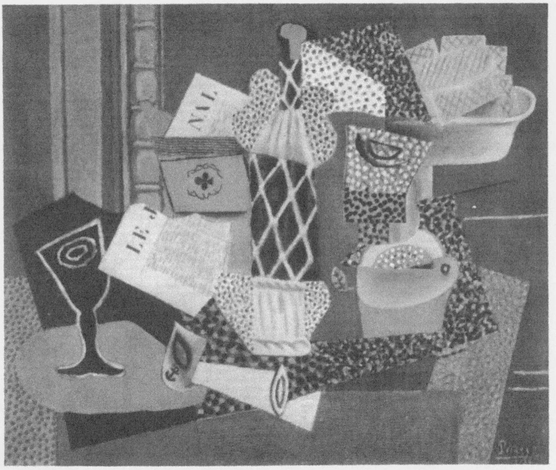
34 LA BOUTEILLE DE MARASQUIN (1914)
Jean Cocteau left for Rome with Picasso, 1917, to prepare Parade. It was the first time that I saw Cocteau, they came together to say good-bye, Picasso was very gay, not so gay as in the days of the great cubist gaiety but gay enough, he and Cocteau were gay, Picasso was pleased to be leaving, he had never seen Italy. He never had enjoyed travelling, he always went where others already were, Picasso never had the pleasure of initiative. As he used to say of himself he has a weak character and he allowed others to make decisions, that is the way it is, it was enough that he should do his work, decisions are never important, why make them.
So cubism was to be put on the stage. That was really the beginning of the general recognition of Picasso’s work, when a work is put on the stage of course every one has to look at it and in a sense if it is put on the stage every one is forced to look and since they are forced to look at it, of course, they must accept it, there is nothing else to do. In the spring of 1917 Picasso was in Italy with Diaghelew and with Cocteau and he made the stage settings and the costumes for Parade which is completely cubist.
1 comment